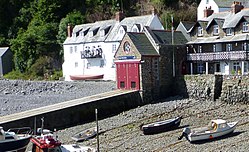|
Clovelly Lifeboat Station
Clovelly Lifeboat Station, serving the North Devon village of Clovelly and surrounding coastal waters, is run by the Royal National Lifeboat Institution (RNLI). It was established in 1870. The station is flanked by Appledore to the northeast and Bude to the southwest. HistoryThe first station was opened in 1870 after several boats had been wrecked in the area.[2] The boathouse cost £175 to build.[3] The station was rebuilt in 1892 and a slipway provided.[2] The Coxswain in 1908 was Thomas Pengilly, who became the then longest-serving coxswain in the service.[4][5] A news article of 1935 noted that he had served Clovelly lifeboat for over 48 years, 14 as Second Coxswain and 24 as Coxswain.[6] In the 32 years from 1899 the lifeboat saved 158 lives.[7] Pengilly retired in 1929 after 54 years of service to the RNLI; he was succeeded as coxswain by Alfred Braund.[8] Coxswain Braund was succeeded in 1932 by J. J. Headon, who retired in 1936 at the age of 60 after 40 years’ service.[9] Coxswain in 1948 was G. Lamey.[10] By 1950 the lifeboat was reported to have saved 328 lives in its 80 years since established.[11] The RNLI closed the station in August 1988 as fast lifeboats at Padstow and Appledore could cover the area around Clovelly. The lifeboat house was given Grade II status in 1989.[1] The Clovelly Trust provided an inshore lifeboat (ILB) in 1990 and this was operated by them from the RNLI's old boathouse until 1997. The RNLI returned to Clovelly with their own ILB on 14 May 1998.[2] The lifeboat house was modified in 1999 so that the lifeboat and its tractor could be stored together. A separate building was provided in 2005 for a bulldozer which is used to keep the beach in good shape for launching the lifeboat.[1] In 2011, Thomas Pengilly's great-great-granddaughter Lauren McGuire, 27, became Britain's youngest station manager when she was appointed to Clovelly Lifeboat Station after 10 years' service with the RNLI. She is the fifth generation of her family to serve with Clovelly lifeboat.[4] In the same year a tragedy occurred when Helmsman Jonny Staines went missing; his body was found at Hartland Quay.[12] Notable services During a gale on 16 August 1903 the lifeboat launched to two vessels in distress, the schooner Mary Stewart and the yacht Gadfly and rescued both their crews, eight people in all.[13] On 12 February 1906 in Bideford Bay the Clovelly lifeboat stood by the steamer Peruvian (5,000 tons and 30 crew), who had lost her rudder in stormy seas, for five hours during the night until steam tugs could reach the steamer.[14] On 7 February 1913 the lifeboat rescued the six crew of the schooner Ianthe in a strong gale.[15] In 1962 the lifeboat rescued the seven-man crew from the 3,000 tonne tanker Green Ranger when she was wrecked off Hartland after a towing cable parted.[4] AwardsThree RNLI Silver Medals and four Bronze Medals have been awarded to Clovelly lifeboat crews, and a silver medal to a Coastguard officer the year before the lifeboat service's inauguration.[3] Coxswain Richard Headon was awarded the Silver Medal of the RNLI in 1882 for his service with the Clovelly Lifeboat Station.[16] The following are awards made to the crew of Clovelly Lifeboats[17]
Clovelly lifeboats In 1916 the station was operating the Elinor Roget. A newspaper report described how women helped to launch the lifeboat in the event of fishermen being unavailable.[18] In 1936 the 35-foot motor lifeboat City of Nottingham (built in 1929) was transferred to Clovelly from Hythe.[9] In 1950 the station launched a new motor lifeboat William Cantrell Ashley, a 35-foot, twin 18 horsepower self-righting vessel, equipped with a radio and under the command of Coxswain George Lamey. It was the fifth lifeboat in 80 years to be stationed at Clovelly.[11] The current lifeboat is B-class inshore lifeboat Toby Rundle (B-872), funded by the Rundle Family of Williton, Somerset.[3][19] Lifeboats 1870-1988
Inshore lifeboats from 1990
See alsoReferences
Further reading
External linksWikimedia Commons has media related to Clovelly Lifeboat Station. |
|||||||||||||||||||||||||||||||||||||||||||||||||||||||||||||||||||||||||||||||||||||||||||||||||||||||||||||||||||||||||
Portal di Ensiklopedia Dunia


